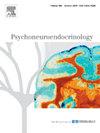Exposure to EP-1 during lactation on maternal behavior, offspring early development, quinestrol transfer and relative receptors in maternal and offspring of Kunming mice
IF 3.6
2区 医学
Q2 ENDOCRINOLOGY & METABOLISM
引用次数: 0
Abstract
Maternal exposure to EP-1 (quinestrol: levonorgestrel = 1:2) during lactation harms the gonads and the reproduction of offspring. However, it is not clear how the mother’s exposure causes damage to the offspring, whether offspring are exposed to EP-1 through mother's milk, or how it affects the early neurodevelopment of the offspring. A control group, low-dose group, and high-dose group were administered EP-1 at 0, 3, and 5 mg/kg, respectively, and changes in maternal behaviors, hormones, relevant receptor expression in the brain and mammary glands, and quinestrol levels in blood and milk were examined. Offspring survival, body weight, hormone levels, and brain receptor expression were examined too. EP-1 exposure increased maternal behavior, serum estradiol, and oxytocin levels, but decreased prolactin. EP-1 exposure elevated estrogen receptor 1 and oxytocin receptor expression in the medial preoptic area (MPOA), ventral tegmental area (VTA), and estrogen receptor 1 in the mammary tissue, but decreased prolactin receptor expression in the MPOA, VTA, and mammary glands. Quinestrol was found in the blood and milk of maternal mice. In early pups, EP-1 exposure decreased offspring survival, body weight, testosterone, and growth hormone levels, and increased serum estradiol. EP-1 exposure decreased estrogen receptors 1 and 2 in the hypothalamus (HYP) and amygdala, and kisspeptin receptors (Kiss1R) in HYP in female offspring, but increased Kiss1R in male offspring. In conclusion, maternal EP-1 exposure during lactation increases maternal behavior and corresponding neuroendocrine hormones; quinestrol transmitted through milk and reduced milk may affect early offspring development, especially the neuroendocrine system.
哺乳期暴露EP-1对昆明小鼠母鼠行为、子代早期发育、喹雌酮转移及相关受体的影响
母亲在哺乳期暴露于EP-1(喹雌酮:左炔诺孕酮= 1:2)会损害性腺和后代的繁殖。然而,目前尚不清楚母亲的接触如何对后代造成损害,后代是否通过母乳接触到EP-1,以及它如何影响后代的早期神经发育。对照组、低剂量组、高剂量组分别以0、3、5 mg/kg剂量给药EP-1,观察母体行为、激素、脑、乳腺相关受体表达及血、乳中喹雌酮水平的变化。后代的存活率、体重、激素水平和大脑受体表达也进行了检查。EP-1暴露增加了母体行为、血清雌二醇和催产素水平,但降低了催乳素。EP-1暴露可提高乳腺组织中内侧视前区(MPOA)、腹侧被盖区(VTA)和雌激素受体1的表达,但降低MPOA、VTA和乳腺中催乳素受体的表达。在母鼠的血液和乳汁中发现了喹雌酚。在早期幼崽中,EP-1暴露降低了幼崽的存活率、体重、睾酮和生长激素水平,并增加了血清雌二醇。EP-1暴露降低了雌性后代下丘脑(HYP)和杏仁核中的雌激素受体1和2以及HYP中的kisspeptin受体(Kiss1R),但增加了雄性后代的Kiss1R。综上所述,哺乳期母体EP-1暴露增加了母体行为和相应的神经内分泌激素;喹雌酚通过乳汁和还原乳汁传播,可能影响后代早期发育,尤其是神经内分泌系统。
本文章由计算机程序翻译,如有差异,请以英文原文为准。
求助全文
约1分钟内获得全文
求助全文
来源期刊

Psychoneuroendocrinology
医学-精神病学
CiteScore
7.40
自引率
8.10%
发文量
268
审稿时长
66 days
期刊介绍:
Psychoneuroendocrinology publishes papers dealing with the interrelated disciplines of psychology, neurobiology, endocrinology, immunology, neurology, and psychiatry, with an emphasis on multidisciplinary studies aiming at integrating these disciplines in terms of either basic research or clinical implications. One of the main goals is to understand how a variety of psychobiological factors interact in the expression of the stress response as it relates to the development and/or maintenance of neuropsychiatric illnesses.
 求助内容:
求助内容: 应助结果提醒方式:
应助结果提醒方式:


